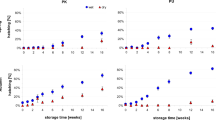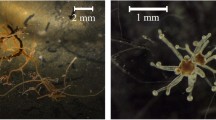Abstract
Worldwide freshwater salinization may significantly alter ecosystem functioning and affect biodiversity. We studied the effect of salinity on hatching success of resting eggs of different ages and life history traits of post-diapause females of cladoceran Moina macrocopa. The hatching success of resting eggs was almost unaffected by the salinity we tested (up to 5.9 g L−1). We observed a distinct difference in the hatching success of resting eggs of different ages, which was lower by ca. 50% for 4-year-old resting eggs compared with 1-year-old resting eggs. We found a decrease in the values of the life-history traits of the females hatched from 4-year-old resting eggs compared with the females hatched from 1-year-old resting eggs exposed to salinity within the range of 0.08–3.5 g L−1: a shorter lifespan, a lower juvenile somatic growth rate, a delay in the day of the first reproduction, and a smaller number of parthenogenetic clutches produced. Analysis showed that at a salinity of 3.5 g L−1, females hatched from resting eggs are more vulnerable to the effect of salinity than directly developing females. The post-diapause females exposed to salinity showed a shorter lifespan and reduced reproduction parameters (produced fewer clutches and neonates) compared with the directly developing females. Thus, the hatching of resting eggs can be considered as a critical period of the development of a species with the diapause in its life cycle due to the vulnerability of post-diapause females to increased salinity, which can be crucially important for the ecological success of the population.




Similar content being viewed by others
Data availability
Data, associated metadata, and calculation tools are available from the corresponding author (lopatinats@mail.ru).
Code availability
All used packages and used tools have been cited in the manuscript, and there is no specific code for this manuscript.
References
Alekseev VR, Starobogatov YI (1996) Types of diapause in Crustacea: definitions, distribution, evolution. Hydrobiologia 320:15–26. https://doi.org/10.1007/BF00016801
Alekseev VR, de Stasio BT, Gilbert JJ (2007) Diapause in aquatic invertebrates: theory and human use. Springer, Netherlands
Amsinck SL, Jeppesen E, Verschuren D (2007) Use of cladoceran resting eggs to trace climate-driven and anthropogenic changes in aquatic ecosystems. In: Alekseev VR, De Stasio BT, Gilber JJ (eds) Diapause in aquatic invertebrates: theory and human use. Springer, pp 135–157
Arbačiauskas K (2004) Seasonal phenotypes of Daphnia: post-diapause and directly developing offspring. J Limnol 63(1):7–15. https://doi.org/10.4081/jlimnol.2004.s1.7
Bailey SA, Duggan IC, van Overdijk CDA, Johengen TH, Reid DF, MacIsaac HJ (2004) Salinity tolerance of diapausing eggs of freshwater zooplankton. Freshw Biol 49:286–295. https://doi.org/10.1111/j.1365-2427.2004.01185.x
Brucet S, Boix D, Quintana XD, Jensen E, Nathansen LW, Trochine C, Meerhoff M, Gascón S, Jeppesen E (2010) Factors influencing zooplankton size structure at contrasting temperatures in coastal shallow lakes: implications for effects of climate change. Limnol Oceanogr 55(4):1697–1711. https://doi.org/10.4319/lo.2010.55.4.1697
Carvalho GR, Hughes RN (1989) The effect of food availability, female culture-density and photoperiod on ephippia production in Daphnia magna Straus (Crustacea, Cladocera). Freshw Biol 13:37–46. https://doi.org/10.1111/j.1365-2427.1983.tb00655.x
Carvalho GR, Wolf HG (1989) Resting eggs of lake-Daphnia I. Distribution, abundance and hatching of eggs collected from various depths in lake sediments. Freshw Biol 22:459–470. https://doi.org/10.1111/j.1365-2427.1989.tb01118.x
Corsi SR, Graczyk DJ, Geis SW, Booth NL, Richards KD (2010) Fresh look at road salt: aquatic toxicity and water quality impacts on local, regional, and national scale. Environ Sci Technol 44(19):7376–7382. https://doi.org/10.1021/es101333u
Cunillera-Montcusí D, Beklioğlu M, Cañedo-Argüelles M et al (2022) Freshwater salinization: a research agenda for a saltier world. Trends Ecol Evol 37:440–453. https://doi.org/10.1016/j.tree.2021.12.005
Dugan HA, Bartlett SL, Burked SM et al (2017) Salting our freshwater lakes. PNAS 114(17):4453–4458. https://doi.org/10.1073/pnas.1620211114
Ellner S, Hairston NG Jr (1994) Role of overlapping generations in maintaining genetic variation in a fluctuating environment. Am Nat 143(3):403–417
Frąk M, Bednarczyk P (2021) Can winter road de-icing affect mortality of organisms in aquatic ecosystems? An experimental. Approach Water 13:2524. https://doi.org/10.3390/w13182524
García-Zamorano J, Jiménez-Contreras J (2023) Zooplankton egg bank: characterization and effect of biotic factors on hatching. Int J Lim. https://doi.org/10.1051/limn/2023002
Godwin KS, Hafner SD, Buff MF (2003) Long-term trends in sodium and chloride in the Mohawk River, New York: the effect of fifty years of road-salt application. Environ Pollut 124:273–281. https://doi.org/10.1016/S0269-7491(02)00481-5
Hairston NG (1996) Zooplankton egg banks as biotic reservoirs in changing environments. Limnol Oceanogr 41(5):1087–1092. https://doi.org/10.4319/lo.1996.41.5.1087
Hairston NG Jr, Brunt RAV, Kearns CM, Engstrom DR (1995) Age and survivorship of diapausing eggs in a sediment egg bank. Ecology 76:1706–1711. https://doi.org/10.2307/1940704
Huang J, Li Y, Sun Y, Zhang L, Lyu K, Yang Z (2022) Size-specific sensitivity of cladocerans to freshwater salinization: evidences from the changes in life history and population dynamics. Environ Pollut 296:118770. https://doi.org/10.1016/j.envpol.2021.118770
Jiang X, Zhao S, Xu Z et al (2012) Abundance and age of viable resting eggs of the calanoid copepod Boeckella poppei Mrázek in sediments: evidence of egg banks in two antarctic maritime lakes. Polar Biol 35:1525–1531. https://doi.org/10.1007/s00300-012-1192-5
Kaushal SS, Likens GE, Pace ML et al (2021) Freshwater salinization syndrome: from emerging global problem to managing risks. Biogeochemistry 154:255–292. https://doi.org/10.1007/s10533-021-00784-w
Kotalik CJ, Clements WH, Cadmus P (2017) Effects of magnesium chloride road deicer on montane stream benthic communities. Hydrobiologia 799(5):193–202. https://doi.org/10.1007/s10750-017-3212-5
Lin Q, Xu L, Liu Z, Jeppesen E, Han B-P (2017) Responses of trophic structure and zooplankton community to salinity and temperature in Tibetan Lakes: implication for the effect of climate. Wat Res 124:618–629. https://doi.org/10.1016/j.watres.2017.07.078
Lopatina TS, Aleksandrova YV, Anishchenko OV, Gribovskaya IV, Oskina NA, Zotina TA, Zadereev ES (2020) The effect of deicing salt solutes on Moina macrocopa and Allium cepa in a toxicity test experiment. Vestnik Tomskogo Gosudarstvennogo Universiteta Biologiya. Tomsk State Univ J Biol 51:162–178. https://doi.org/10.17223/19988591/51/9
Lopatina T, Anishchenko O, Oskina N, Zadereev E (2021) Threshold concentrations of the road salt for adverse effects on females and resting eggs of cladoceran Moina macrocopa. Aquat Ecol 55:283–297. https://doi.org/10.1007/s10452-021-09830-z
Mabidi A, Bird MS, Perissinotto R (2018) Increasing salinity drastically reduces hatching success of crustaceans from depression wetlands of the semi-arid Eastern Cape Karoo region. South Africa Sci Rep 8:5983. https://doi.org/10.1038/s41598-018-24137-0
Marcus NH, Lutz R, Burnett W, Cable P (1994) Age, viability, and vertical distribution of zooplankton resting eggs from an anoxic basin: evidence of an egg bank. Limnol Oceanogr 39(1):154–158. https://doi.org/10.4319/lo.1994.39.1.0154
Martınez-Jeronimo F, Martınez-Jeronimo L (2007) Chronic effect of NaCl salinity on a freshwater strain of Daphnia magna Straus (Crustacea: Cladocera): a demographic study. Ecotoxicol Environ Saf 67(3):411–416. https://doi.org/10.1016/j.ecoenv.2006.08.009
Meter RJV, Swan ChM, Leips J, Snodgrass JW (2011) Road salt stress induces novel food web structure and interactions. Wetlands 31(5):843–851. https://doi.org/10.1007/s13157-011-0199-y
Mungenge CP, Wasserman RJ, Cuthbert RN et al (2023) Salinisation of arid temporary pools alters crustacean hatching success but not phenology dynamics. Hydrobiologia. https://doi.org/10.1007/s10750-023-05325-0
Nielsen DL, Smith D, Petrie R (2012) Resting egg banks can facilitate recovery of zooplankton communities after extended exposure to saline conditions. Freshw Biol 57(6):1306–1314. https://doi.org/10.1111/j.1365-2427.2012.02782.x
Organization standard STO 001-80119761–2010 (2016) Deicing materials Bionord. Technical conditions. Ural Plant of Deicing Materials LLC. Perm, p 26. https://bionord.store/upload/iblock/f42/_-_-_-_-_-_-_-2018_19.pdf. Accessed 23 Aug 2023
Oskina N, Lopatina T, Anishchenko O, Zadereev E (2019) High resistance of resting eggs of cladoceran Moina macrocopa to the effect of heavy metals. Bull Environ Contam Toxicol 102(3):335–340. https://doi.org/10.1007/s00128-018-2473-7
Paes TASV, Rietzler AC, Maia-Barbosa PM (2016) Methods for selection of Daphnia resting eggs: the influence of manual decapsulation and sodium hypoclorite solution on hatching rates. Braz J Biol 76(4):1058–1063. https://doi.org/10.1590/1519-6984.09415
Reid AJ, Carlson AK, Creed IF et al (2019) Emerging threats and persistent conservation challenges for freshwater biodiversity. Biol Rev 94(3):849–873. https://doi.org/10.1111/brv.12480
Ritz Ch, Streibig JC (2005) Bioassay analysis using R. J Statistical Softw. https://doi.org/10.18637/jss.v012.i05
Santangelo JM, Araújo LR, de Esteves F, MancaBozelli MRL (2011) Method for hatching resting eggs from tropical zooplankton: effects of drying or exposing to low temperatures before incubation. Acta Limnol Bras 23:42–47. https://doi.org/10.4322/actalb.2011.017
Santangelo JM, Esteves FDA, Manca M, Bozelli RL (2014) Disturbances due to increased salinity and the resilience of zooplankton communities: the potential role of the resting egg bank. Hydrobiologia 722:103–113. https://doi.org/10.1007/s10750-013-1683-6
Sarma SSS, Nandini S, Morales-Ventura J, Delgado-Martinez I, Gonzalez-Valverde L (2006) Effects of NaCl salinity on the population dynamics of freshwater zooplankton (rotifers and cladocerans). Aquat Ecol 40:349–360. https://doi.org/10.1007/s10452-006-9039-1
Schuler MS, Hintz WD, Jones DK, Lind LA, Mattes BM, Stoler AB, Sudol KA, Relyea RA (2017) How common road salts and organic additives alter freshwater food webs: in search of safer alternatives. J Appl Ecol 54(5):1353–1361. https://doi.org/10.1111/1365-2664.12877
Schuytema GS, Nebeker AV, Stutzman TW (1997) Salinity tolerance of Daphnia magna and potential use for estuarine sediment toxicity test. Arch Environ Contam Toxicol 33(2):194–198. https://doi.org/10.1007/s002449900242
Stross RG, Hill RG (1965) Diapause induction in Daphnia requires two stimuli. Science 150:1462–1464. https://doi.org/10.1126/science.150.3702.1462
Szklarek S, Górecka A, Jóźwiak P et al (2022) The effect of road salt (NaCl) treatment on the hatching success of Daphnia magna and Thamnocephalus platyurus. Ecohydrol Hydrobiol. https://doi.org/10.1016/j.ecohyd.2023.06.005
Valleau R, Paterson A, Smol J (2020) Effects of road-salt application on Cladocera assemblages in shallow Precambrian Shield lakes in south-central Ontario. Canada Freshw Sci 39(4):824–836. https://doi.org/10.1086/711666
Velasco J, Gutiérrez-Cánovas C, Botella-Cruz M, Sánchez-Fernández D, Arribas P, Carbonell JA, Millán A, Pallarés S (2019) Effects of salinity changes on aquatic organisms in a multiple stressor context. Philos Trans R Soc Lond B Biol Sci. https://doi.org/10.1098/rstb.2018.0011
Yuslan A, Najuwa S, Hagiwara A, Ghaffar MA, Suhaimi H, Rasdi NW (2021) Production performance of Moina macrocopa (Straus 1820) (Crustacea, Cladocera) cultured in different salinities: the effect on growth, survival, reproduction, and fatty acid composition of the neonates. Diversity 13:105. https://doi.org/10.3390/d13030105
Zadereev ES, Gubanov VG (1996) The role of population density in gametogenesis induction in Moina macrocopa (Cladocera: Crustacea). Zhurnal Obshch Biol 57:360–367
Zadereev E, Lopatina T, Oskina N, Zotina T, Petrichenkov M, Dementyev D (2017) Gamma irradiation of resting eggs of Moina macrocopa affects individual and population performance of hatchlings. J Environ Radioact 175–176:126–134. https://doi.org/10.1016/j.jenvrad.2017.05.002
Zadereev E, Lipka O, Karimov B et al (2020) Overview of past, current and future ecosystem and biodiversity trends of inland saline lakes of Europe and Central Asia. Inland Waters 10(4):438–452. https://doi.org/10.1080/20442041.2020.1772034
Zadereev E, Drobotov A, Anishchenko O, Kolmakova A, Lopatina T, Oskina N, Tolomeev A (2022) The structuring effects of salinity and nutrient status on zooplankton communities and trophic structure in Siberian lakes. Water 14(9):1468. https://doi.org/10.3390/w14091468
Acknowledgements
We are grateful to professional scientific English translator Elena Krasova for linguistic checks and improvements. Two anonymous reviewers are highly acknowledged for valuable comments that improved the earlier version of the manuscript.
Funding
The reported study was funded by Russian Science Foundation and the Krasnoyarsk Regional Fund of Science and Technology Support, Project No. 23-24-10044, https://rscf.ru/project/23-24-10044/
Author information
Authors and Affiliations
Corresponding author
Ethics declarations
Conflict of interest
All the authors declare that there is no conflict of interests.
Ethical approval
All applicable international, national, and/or institutional guidelines for the care and use of animals were followed.
Consent for publication
Not applicable.
Consent to participate
Not applicable.
Additional information
Handling editor: S. S. S. Sarma.
Publisher's Note
Springer Nature remains neutral with regard to jurisdictional claims in published maps and institutional affiliations.
Supplementary Information
Below is the link to the electronic supplementary material.
Rights and permissions
Springer Nature or its licensor (e.g. a society or other partner) holds exclusive rights to this article under a publishing agreement with the author(s) or other rightsholder(s); author self-archiving of the accepted manuscript version of this article is solely governed by the terms of such publishing agreement and applicable law.
About this article
Cite this article
Lopatina, T., Oskina, N. & Zadereev, E. Salinity sensitivity of Moina macrocopa post-diapause females hatched from resting eggs of different ages. Aquat Ecol (2024). https://doi.org/10.1007/s10452-024-10110-9
Received:
Accepted:
Published:
DOI: https://doi.org/10.1007/s10452-024-10110-9




